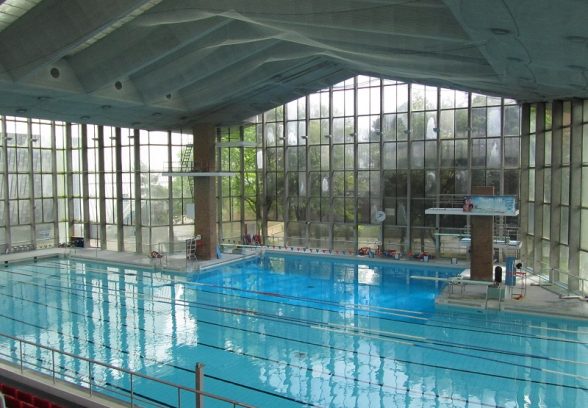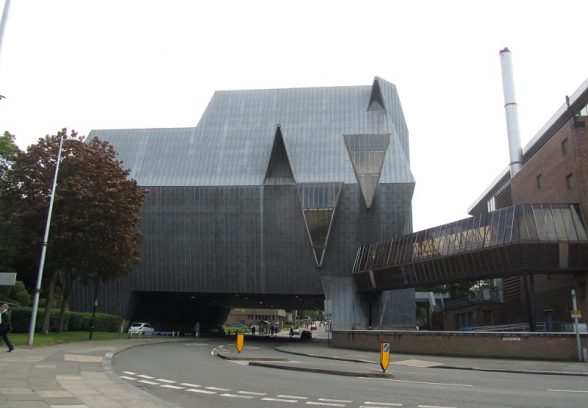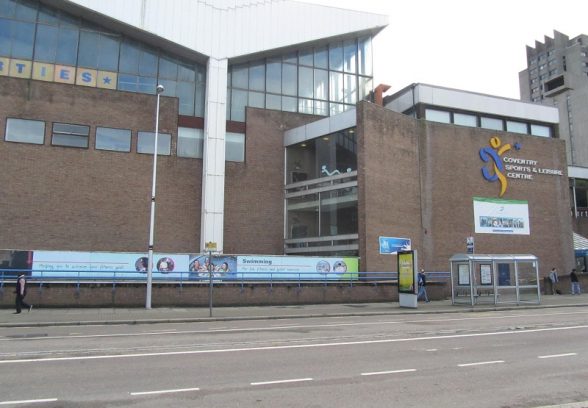This website uses cookies
This website uses cookies to enable it to function properly and to analyse how the website is used. Please click 'Close' to accept and continue using the website.





April 2015 - Coventry Central Baths & Elephant
by Lou Robson
The shabby foyer of Coventry’s central baths holds few clues to the magnificent arena perched above. A modern kiosk is shoehorned into a corner and vending machines obscure the stone plaque marking the opening in 1966 by a Lord Mayor who boasted they were the finest baths in Europe.
The Luftwaffe pilots who devastated the city did not spare Coventry’s pools. Four of the five, including the old central baths, did not survive the war. For a decade after the conflict, the city rebuilt. Once the major cogs of reconstruction – the precinct, the ring road, Basil Spence’s cathedral – were in place, aldermen turned to citizens’ leisure needs.
It took another decade for plans to crystallise and four years to build before Coventry Baths opened on April 23 1966 (with an inaugural dip by international swimmers Graham Sykes, Graham Symonds and Bobby Lord, a display by the Miss O Jones Synchro Swimming Team and a gala of 20 swimming and diving events). In 1977 it gained a quirky and solid extension – the zinc-panelled Elephant – a homage to the city’s emblem.
The Grade II listed complex and its pachyderm companion (unlisted) are now under threat. In August Coventry Council approved plans to close the centre and replace it with a £37 million leisure centre holding a pool half the size of the 50m original.
The designers, city architects Arthur Ling and Terence Gregory and principal architect Michael McLellan, were advised by the Amateur Swimming Association as they created the main pool for the West Midlands, still the only one in the region capable of hosting international competitions. Although, as then chair of the baths committee E.J. Williams pointed out, they were not designed to host an Olympic or Empire Games but “for the citizens of Coventry”.
“The Coventry Baths is yet another expression of a young and invigorating Coventry, built, not only for this generation but the generations of the future. For many years Coventry has been without adequate swimming facilities, and the completion of this scheme is a further stage in the central redevelopment of our great and ancient City. I hope and trust that those who use this building will feel justly proud of the endeavour and forethought that has gone into its design and planning and that it will be the means of providing great pleasure and much benefit to everyone.”
On a site bounded by Fairfax, Cope and Cox Street, south of Coventry’s inescapable ringroad, north of the university (then Lanchester College of Technology) and east of the cathedral, it was designed with three pools, one of international standard at 165′ long (50.292m) and 56′ wide. It has a 16′ 6” (5.028m) diving bay and the main pool descends from a depth of 3′ 3” (0.99m) to 6’6”(1.98m). Another pool was for school and club swimming and third for learners. Spectators were catered for with seating for 1,174 people and a restaurant for 80 overlooking the two large pools.
The centre cost £1.3 million. Noting approvingly the contrast of large expanses of brick and glass, the Architect’s Journal of May 25 1966 praised the cost: “At less than £7 5s a sq ft the building is modestly priced for the high standard of finishes, fittings and servicing that is provided.” Those finishes were grey-pink brick, glass and white mosaic (over pre-cast concrete on the fascias). Interior details included faience benches, floors of quarry tiles and teak, anodised aluminium fittings and white and coloured glazed tiles. Then, as now, its best features are the main pool hall with its W-shaped roof and seven pitched lights over the three storey high glass wall overlooking the sunbathing terraces and gardens. It was air-conditioned, heated by an electrode thermal storage plant and filtration turned over the pool water every three hours (emptying into the culverted Sherbourne river). The new building cost £272,000 a year to run for a charge on the rates equivalent to 2 1/2d.
In 1967, rival publication Architectural Review sent its reporter to Coventry. What was probably a he was impressed by the “W-shaped roof like a great garden-pavilion roof afloat above glass walls” and the view “out into and over the city landscape – the cathedrals new and old, to the south-west, the new College of Technology buildings and trees to southward and the red tile roofs and traffic of Coventry to the south-east.”
It was a beautiful day for the visit and about half the pool “was semi-tropical with sunlight”. “The whole impression of this pool both inside and looking in from outside, is of a happy optimum climate of water and air and light ….the distant city landscape seems to rise beyond a platform of water.”
The AR was taken aback by the entrance: “The north side of the building turns a utilitarian back on the unlovely, unfinished bus station landscape behind.”
Four other pools were profiled in that issue – Rotherhithe Baths and Assembly Hall (1966 W.S.A Williams); Felling, County Durham (1963 J.H. Napper and Partners); Stevenage New Town (1962 L.G.Vincent) and Aberavon South Wales (1965 F.D. Williamson and Associates). Felling Pool closed in 2010; the Afan Lido at Aberavon burnt down in 2009. Many other proud civic buildings of their generation from fire stations to libraries are on death row from the scythes of spending cuts, development pressures, municipal neglect, change of use and public apathy, or worse, antipathy to mid twentieth century buildings. And Coventry Council is only one of many owners of a modern listed building to fail in their statutory responsibility to maintain.
In the 1970s Coventry’s main pool was reduced to a metric-compliant 50m. The restaurant is now a suite of exercise studios, the small pool a splash pool and indoor bathrooms mean the basement slipper baths are long gone, as is the custom of attendants to take swimmers clothes away in wire baskets for safe-keeping. That signature W-shaped ceiling with its frosted glass inserts is covered in netting and diving boards closed because of falling tiles.
Coventry Council argues they are forced to sell. The building costs £2,000 a day to run and according to the Coventry Sports Foundation which runs the site, this is mostly “making things safe, not usable again”.
“We have got to a stage where we simply keep going as long as we can and then inevitably close this site, or we divert the funds used for that to make sure we have a better and more accessible facility. We should not be propping up facilities which are unfit for purpose,” chief executive Paul Breed told the Coventry Telegraph.
Coventry Swimming Club chairman Liz Sykes, who watched her husband Graham take that inaugural dip in 1966, said losing the baths would deal a devastating blow to the club, to elite swimmers throughout the Midlands and deprive the city’s businesses of the financial spin-offs of hosting championships. “It’s very sad because it is an iconic building,” she said.
C20 caseworker Henrietta Billings has been lobbying for a meeting with the council’s cabinet member for Culture, Leisure, Sport and Parks Cr Abdul Khan to explore the building’s possibilities.
“We think it’s a fantastic building but its future is very uncertain and worrying,” she said. “It requires investment and maintenance like any building from the 20th century. Its backlog of repairs need addressing rather than demolition.”
The Coventry Society, which has been instrumental in saving other post-war gems including Coventry’s circular market, is seeking to get the Elephant listed. Chairman Keith Draper told the Coventry Observer: “We shouldn’t be running these hotspots of activity into the ground, we should be giving them every help and assistance to succeed. That’s precisely where the Sports Centre finds itself today – hugely in need of practical support from the council.”
Lou Robson is Secretary of the West Midlands group of C20 Society
Look for past Buildings of the Month by entering the name of an individual building or architect or browsing the drop down list.

Become a C20 member today and help save our modern design heritage.